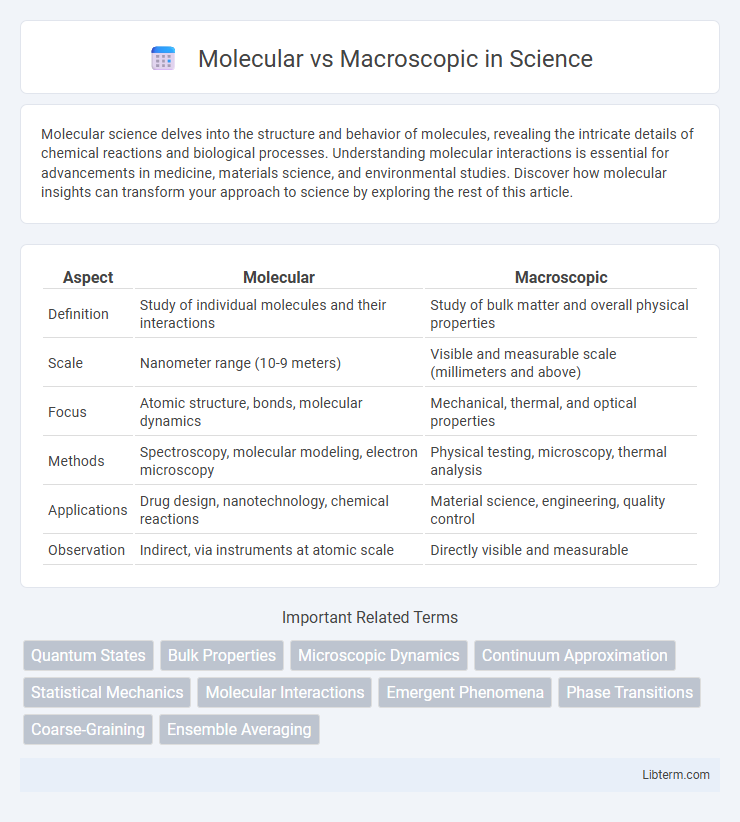Molecular science delves into the structure and behavior of molecules, revealing the intricate details of chemical reactions and biological processes. Understanding molecular interactions is essential for advancements in medicine, materials science, and environmental studies. Discover how molecular insights can transform your approach to science by exploring the rest of this article.
Table of Comparison
| Aspect | Molecular | Macroscopic |
|---|---|---|
| Definition | Study of individual molecules and their interactions | Study of bulk matter and overall physical properties |
| Scale | Nanometer range (10-9 meters) | Visible and measurable scale (millimeters and above) |
| Focus | Atomic structure, bonds, molecular dynamics | Mechanical, thermal, and optical properties |
| Methods | Spectroscopy, molecular modeling, electron microscopy | Physical testing, microscopy, thermal analysis |
| Applications | Drug design, nanotechnology, chemical reactions | Material science, engineering, quality control |
| Observation | Indirect, via instruments at atomic scale | Directly visible and measurable |
Introduction to Molecular and Macroscopic Perspectives
Molecular perspectives examine phenomena at the scale of atoms and molecules, emphasizing the interactions, behaviors, and structures that govern chemical and physical properties. Macroscopic perspectives analyze larger-scale systems where bulk properties, such as temperature, pressure, and volume, arise from the collective behavior of countless molecules. Understanding both views enables deeper insights into processes ranging from chemical reactions to material properties.
Defining the Molecular Scale
The molecular scale refers to dimensions typically ranging from 0.1 to 10 nanometers, where individual atoms and molecules interact according to quantum mechanics and chemical bonding principles. At this scale, properties such as molecular vibrations, electronic configurations, and intermolecular forces govern physical and chemical behavior, contrasting sharply with the continuum assumptions of macroscopic phenomena. Understanding molecular interactions provides critical insight into material properties, reaction mechanisms, and biological functions distinct from bulk characteristics observed at the macroscopic level.
Understanding the Macroscopic World
Understanding the macroscopic world involves analyzing large-scale phenomena that emerge from molecular interactions but are observable without specialized equipment. Macroscopic properties like temperature, pressure, and volume arise from the collective behavior of molecules governed by thermodynamic laws and statistical mechanics. Bridging molecular dynamics and macroscopic observations enables advancements in material science, fluid dynamics, and engineering applications.
Key Differences: Molecular vs. Macroscopic Observations
Molecular observations focus on individual atoms and molecules, revealing interactions at the nanoscale that govern chemical properties and reactions. Macroscopic observations involve bulk properties like temperature, pressure, and volume, measurable directly without specialized equipment. Understanding the key differences between molecular and macroscopic perspectives is crucial for interpreting phenomena ranging from chemical bonding to material behaviors.
Tools for Studying Molecular Structures
X-ray crystallography, nuclear magnetic resonance (NMR) spectroscopy, and cryo-electron microscopy are primary tools for studying molecular structures, providing atomic-level detail essential for understanding molecular composition and function. Atomic force microscopy (AFM) and scanning tunneling microscopy (STM) bridge molecular and macroscopic scales by visualizing surfaces with near-atomic resolution. These techniques enable precise analysis of molecular interactions, conformations, and structural dynamics that are critical in fields like biochemistry, pharmacology, and nanotechnology.
Techniques for Macroscopic Analysis
Macroscopic analysis techniques, such as optical microscopy, tensile testing, and thermal analysis, enable detailed examination of materials' bulk properties like strength, elasticity, and heat resistance. Techniques like scanning electron microscopy (SEM) and X-ray diffraction (XRD) provide insights into surface morphology and crystallographic structure on a larger scale than molecular methods. These macroscopic methods are crucial for assessing performance characteristics in engineering, materials science, and quality control applications.
Applications in Science and Technology
Molecular-level analysis drives innovations in pharmaceuticals by enabling precise drug design through understanding atomic interactions, while macroscopic approaches advance materials engineering by optimizing bulk properties for structural integrity and durability. Nanotechnology leverages molecular manipulation to create devices with enhanced functionality, whereas macroscopic techniques support large-scale manufacturing and quality control in industrial settings. Combining molecular insights with macroscopic assessments enhances the development of advanced composites, biomedical devices, and environmental sensors.
Case Studies: Molecular vs. Macroscopic Phenomena
Molecular phenomena, such as Brownian motion and chemical reactions, are governed by atomic-level interactions and quantum mechanics, as demonstrated in case studies exploring molecular diffusion and enzyme kinetics. Macroscopic phenomena, like fluid dynamics and structural deformation, arise from collective behaviors of vast molecular assemblies and obey classical physics principles, exemplified by case analyses in turbulent flow and bridge engineering. Comparing these scales reveals critical insights into how molecular mechanisms translate into observable macroscopic effects, essential for fields like materials science and biophysics.
Challenges in Bridging Molecular and Macroscopic Scales
Bridging molecular and macroscopic scales poses significant challenges due to the vast differences in spatial and temporal dimensions, which complicate direct correlations between atomic-level interactions and bulk material properties. Accurately modeling such multiscale phenomena requires sophisticated computational methods and experimental techniques that can capture molecular dynamics and translate them into observable macroscopic behavior. Bridging this gap is essential for advancing fields like materials science, nanotechnology, and biomedical engineering, where precise control over molecular processes influences large-scale functionality.
Future Directions in Multiscale Research
Future directions in multiscale research emphasize integrating molecular-level simulations with macroscopic models to enhance predictive accuracy in complex systems. Advances in machine learning and high-performance computing enable seamless bridging of quantum, atomic, and continuum scales, fostering innovations in material design and biomedical applications. Emphasizing cross-scale data fusion and adaptive algorithms will accelerate discovery and optimization across disciplines.
Molecular Infographic

 libterm.com
libterm.com